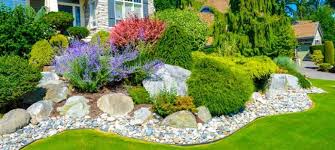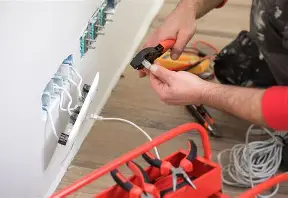Beyond the Lawn: How Smart Landscaping Can Turn Your Yard into a Low-Maintenance Paradise

When you think of a beautiful yard, chances are a lush green lawn comes to mind. For decades, the traditional turf grass lawn has been the hallmark of curb appeal. But in today’s world—where time, water, and maintenance resources are at a premium—homeowners are reimagining what outdoor beauty looks like. Welcome to the era of smart landscaping, where form meets function, and your yard becomes a sustainable, low-maintenance paradise.
________________________________________
The Lawn Dilemma: Beautiful but Demanding
Lawns require a lot—frequent mowing, regular watering, fertilization, and pest control. According to the Environmental Protection Agency (EPA), a traditional lawn can consume up to 9 billion gallons of water per day in the U.S. during peak summer months (EPA Source). That’s a staggering amount, especially in regions battling drought and climate change. On top of that, homeowners spend countless hours or dollars on upkeep.
These demands have sparked a movement toward smarter, more eco-conscious landscaping solutions. The goal? Reduce time, expense, and environmental impact—while still having an outdoor space that’s as inviting as it is impressive.
________________________________________
What Is Smart Landscaping?
Smart landscaping involves designing your outdoor space with efficiency, sustainability, and ease of maintenance in mind. It’s not about sacrificing aesthetics; rather, it’s about using the right elements—plants, materials, and layout—to minimize upkeep and resource consumption.
Here are the core principles:
1. Right Plant, Right Place: Choose native or drought-resistant plants that thrive in your specific climate without extra water or fertilizers.
2. Efficient Irrigation: Use drip irrigation or smart sprinkler systems that reduce waste.
3. Mulching and Ground Covers: Limit weed growth and lock in soil moisture with organic mulch or low-maintenance ground covers.
4. Functional Hardscaping: Use rock, gravel, pavers, and raised beds to add structure and reduce lawn space.
5. Soil Health Management: Healthy soil equals thriving plants. Composting and soil testing can drastically reduce the need for chemical intervention.
________________________________________
Native Plants: The Secret Weapon
One of the smartest decisions you can make in landscaping is incorporating native plants. These species have evolved to thrive in your region’s specific soil, rainfall, and temperature conditions, meaning they require less water, fewer pesticides, and less maintenance overall.
For example, if you live in the Southwest, succulents like agave or desert spoon offer beauty with very little water. In the Midwest, black-eyed Susans or purple coneflowers can handle temperature swings and require minimal upkeep.
A study by the U.S. Forest Service found that landscapes using native plants can reduce the need for water by up to 60% compared to traditional turf-based yards (USFS Source). That’s not just environmentally responsible—it’s financially smart, especially if you’re billed for water usage.
________________________________________
Less Lawn, More Living
Reducing your lawn doesn’t mean eliminating it entirely (unless you want to). Instead, consider blending lawn alternatives and functional areas to create a more dynamic and usable yard. Here are a few ideas:
• Gravel or Decomposed Granite Patios: Excellent for seating areas with minimal maintenance needs.
• Artificial Turf Patches: A small, artificial lawn area can provide greenery without the effort.
• Perennial Beds: These bloom year after year, requiring less work than replanting annuals.
• Edible Landscaping: Incorporate low-maintenance herbs, fruit trees, or raised vegetable beds that are both beautiful and functional.
• Dry River Beds and Rock Gardens: Visually stunning and perfect for managing water runoff while reducing plant care requirements.
The key is to tailor your space to your lifestyle. If you don’t spend weekends tending the yard, why design a space that demands it?
________________________________________
Smart Irrigation and Water Savings
Water conservation is central to smart landscaping. Conventional sprinklers often spray indiscriminately—watering sidewalks as much as plants—and operate on timers that don’t account for rainfall. Smart irrigation systems, on the other hand, use sensors to monitor soil moisture, weather forecasts, and plant needs in real time.
Drip irrigation delivers water directly to the plant roots, minimizing evaporation. Pair that with a rain barrel collection system and mulched beds, and you’ll drastically cut your water use.
Modern smart sprinkler controllers can be connected to Wi-Fi and managed via phone apps, allowing homeowners to adjust watering schedules on the go. Some systems even shut off automatically when it rains.
________________________________________
The Power of Mulch and Ground Covers
One of the easiest upgrades you can make is replacing portions of your lawn with mulch or ground covers. Mulch (organic or inorganic) helps soil retain moisture, keeps plant roots cool, and suppresses weeds. It also breaks down over time, improving soil health.
Ground covers like creeping thyme, mondo grass, or blue star creeper provide lush coverage with a fraction of the maintenance required by grass. They rarely need mowing, and many are drought-tolerant.
For pathways or shady spots where grass struggles to grow, these alternatives are both practical and beautiful.
________________________________________
Hardscaping: Beauty with Zero Mowing
Hardscaping refers to the non-living elements in landscaping—stone walls, patios, decks, fire pits, and walkways. These features reduce the need for plant care while increasing functionality and resale value.
By integrating patios with built-in seating, outdoor kitchens, or shaded pergolas, you transform your yard into a true extension of your home. And unlike lawns, hardscape elements don’t need mowing, watering, or fertilizing.
Modern designs often blend natural stone with native plants for an organic yet refined look that’s perfect for low-maintenance living.
________________________________________
Design for Drainage and Sustainability
Poor drainage is one of the most overlooked issues in traditional yards. Pooling water can damage plant roots and create breeding grounds for pests. Smart landscaping incorporates grading, French drains, swales, and permeable paving to ensure water is managed properly.
Rain gardens—planted depressions designed to absorb and filter runoff—are another excellent low-maintenance option. Not only do they improve drainage, but they also support local wildlife and add seasonal beauty to your yard.
________________________________________
Attracting Wildlife the Right Way
Another benefit of smart landscaping is the opportunity to create a backyard habitat. By planting native species, adding bird baths or bee hotels, and eliminating pesticides, you can turn your yard into a haven for butterflies, hummingbirds, and pollinators.
Not only does this support local ecosystems, but it also reduces your reliance on chemical pest control, contributing to a healthier, more self-sustaining landscape.
________________________________________
Smart Landscaping Saves Money Long-Term
Yes, smart landscaping may require more planning up front—and in some cases, a bit more investment. But the long-term savings are substantial.
• Less water use
• Lower utility bills (shade trees can reduce AC costs)
• Fewer chemical products
• Reduced need for lawn services or equipment
Not to mention, your weekends will be a lot more relaxing when you’re not tied to mowing, weeding, or fertilizing.
________________________________________
Final Thoughts: A Yard That Works for You
The idea of a perfect yard is evolving. Today, the smartest outdoor spaces are designed with intention—balancing aesthetics with efficiency and sustainability. You don’t need acres of lawn or endless rows of shrubs to make a statement. With the right strategy, you can have a stunning outdoor retreat that practically takes care of itself.
Smart landscaping isn’t just a trend—it’s a shift in how we live with the land. It’s about working with nature instead of against it. Whether you’re revamping a small urban backyard or redesigning a sprawling suburban plot, smart landscaping empowers you to create a space that reflects your lifestyle while minimizing effort.
So go beyond the lawn. Reimagine your yard as a space of beauty, balance, and bliss—without the burden.
________________________________________
Sources:
• EPA WaterSense – Outdoor Water Use in the United States
• USDA Forest Service – Native Plants for Landscaping
Note: IndiBlogHub features both user-submitted and editorial content. We do not verify third-party contributions. Read our Disclaimer and Privacy Policyfor details.







